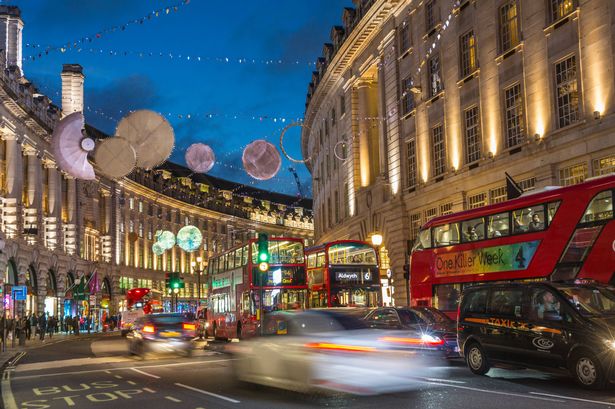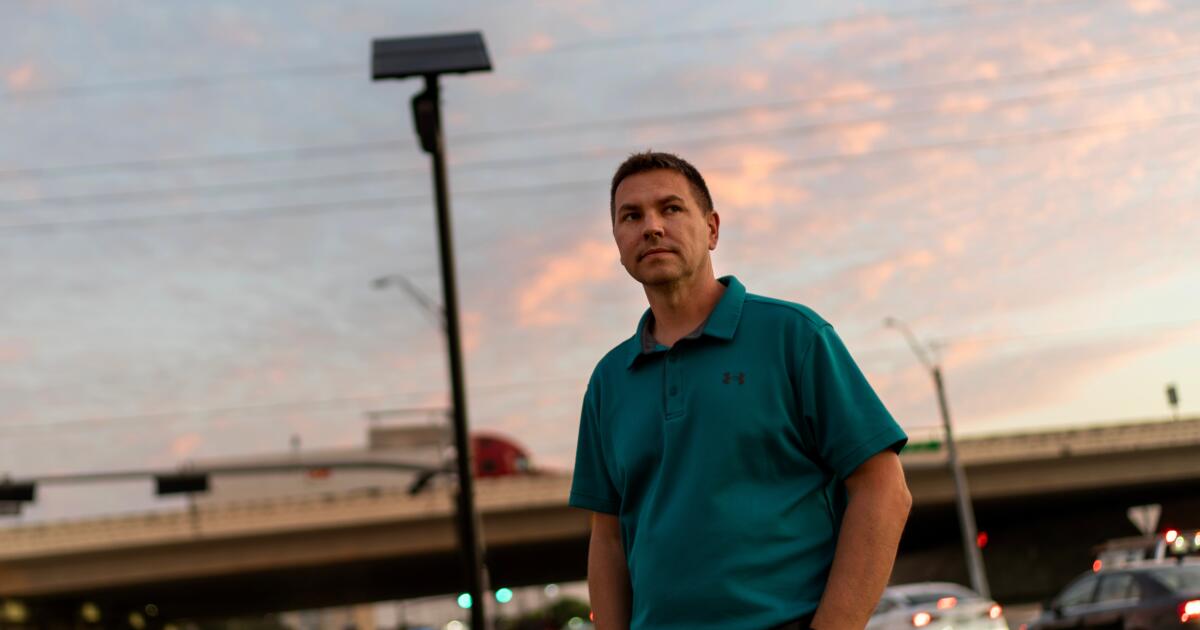The U.S. Border Patrol is monitoring millions of American drivers nationwide in a secretive program to identify and detain people whose travel patterns it deems suspicious, the Associated Press has found.
The predictive intelligence program has resulted in people being stopped, searched and in some cases arrested. A network of cameras scans and records vehicle license plate information, and an algorithm flags vehicles deemed suspicious based on where they came from, where they were going and which route they took. Federal agents in turn may then flag local law enforcement.
Suddenly, drivers find themselves pulled over — often for reasons cited such as speeding, failure to signal, the wrong window tint or even a dangling air freshener blocking the view. They are then aggressively questioned and searched, with no inkling that the roads they drove put them on law enforcement’s radar.
Once limited to policing the nation’s boundaries, the Border Patrol has built a surveillance system stretching into the country’s interior that can monitor ordinary Americans’ daily actions and connections for anomalies instead of simply targeting wanted suspects. Started about a decade ago to fight illegal border-related activities and the trafficking of drugs and people, it has expanded over the last five years.
The Border Patrol has recently grown even more powerful through collaborations with other agencies, drawing information from license plate readers nationwide run by the Drug Enforcement Administration, private companies and, increasingly, local law enforcement programs funded through federal grants. Texas law enforcement agencies have asked Border Patrol to use facial recognition to identify drivers, documents show.
This active role beyond the borders is part of the quiet transformation of its parent agency, U.S. Customs and Border Protection, into something more akin to a domestic intelligence operation. Under the Trump administration’s heightened immigration enforcement efforts, CBP is now poised to get more than $2.7 billion to build out border surveillance systems such as the license plate reader program by layering in artificial intelligence and other emerging technologies.
The result is a mass surveillance network with a particularly American focus: cars.
This investigation, the first to reveal details of how the program works on America’s roads, is based on interviews with eight former government officials with direct knowledge of the program who spoke on the condition of anonymity because they weren’t authorized to speak to the media, as well as dozens of federal, state and local officials, attorneys and privacy experts. The AP also reviewed thousands of pages of court and government documents, state grant and law enforcement data, and arrest reports.
The Border Patrol has for years hidden details of its license plate reader program, trying to keep any mention of the program out of court documents and police reports, former officials say, even going so far as to propose dropping charges rather than risk revealing any details about the placement and use of their covert license plate readers. Readers are often disguised along highways in traffic safety equipment like drums and barrels.
The Border Patrol has defined its own criteria for which drivers’ behavior should be deemed suspicious or tied to drug or human trafficking, stopping people for anything from driving on backcountry roads, being in a rental car or making short trips to the border region. The agency’s network of cameras now extends along the southern border in Texas, Arizona and California, and also monitors drivers traveling near the U.S.-Canada border.
And it reaches far into the interior, affecting residents of big metropolitan areas and people driving to and from large cities such as Chicago and Detroit, as well as from Los Angeles, San Antonio and Houston to and from the Mexican border region. In one example, AP found the agency has placed at least four cameras in the greater Phoenix area over the years, one of which was more than 120 miles from the Mexican frontier, beyond the agency’s usual jurisdiction of 100 miles from a land or sea border. The AP also identified several camera locations in metropolitan Detroit, as well as one placed near the Michigan-Indiana border to capture traffic headed toward Chicago or Gary, Ind., or other nearby destinations.
Border Patrol’s parent agency, U.S. Customs and Border Protection, said it uses license plate readers to help identify threats and disrupt criminal networks and are “governed by a stringent, multi-layered policy framework, as well as federal law and constitutional protections, to ensure the technology is applied responsibly and for clearly defined security purposes.”
“For national security reasons, we do not detail the specific operational applications,” the agency said. While the U.S. Border Patrol primarily operates within 100 miles of the border, it is legally allowed “to operate anywhere in the United States,” the agency added.
While collecting license plates from cars on public roads has generally been upheld by courts, some legal scholars see the growth of large digital surveillance networks such as Border Patrol’s as raising constitutional questions. Courts have started to recognize that “large-scale surveillance technology that’s capturing everyone and everywhere at every time” might be unconstitutional under the 4th Amendment, which protects people from unreasonable searches, said Andrew Ferguson, a law professor at George Washington University.
Today, predictive surveillance is embedded into America’s roadways. Mass surveillance techniques are also used in other countries, including authoritarian governments such as China and, increasingly, democracies in the United Kingdom and Europe in the name of national security and public safety.
“They are collecting mass amounts of information about who people are, where they go, what they do, and who they know … engaging in dragnet surveillance of Americans on the streets, on the highways, in their cities, in their communities,” Nicole Ozer, the executive director of the Center for Constitutional Democracy at UC Law San Francisco, said in response to the AP’s findings. “These surveillance systems do not make communities safer.”
‘We did everything right and had nothing to hide’
In February, Lorenzo Gutierrez Lugo, a driver for a small trucking company that specializes in transporting furniture, clothing and other belongings to families in Mexico, was driving south to the border city of Brownsville, Texas, carrying packages from immigrant communities in South Carolina’s low country.
Gutierrez Lugo was pulled over by a local police officer in Kingsville, a small Texas city near Corpus Christi that lies about 100 miles from the Mexico border. The officer, Richard Beltran, cited the truck’s speed of 50 mph in a 45 mph zone as the reason for the stop.
But speeding was a pretext: Border Patrol had requested the stop and said the black Dodge pickup with a white trailer could contain contraband, according to police and court records. U.S. Route 77 passes through Kingsville, a route that state and federal authorities scrutinize for trafficking of drugs, money and people.
Gutierrez Lugo, who through a lawyer declined to comment, was interrogated about the route he drove, based on license plate reader data, per the police report and court records. He consented to a search of his car by Beltran and Border Patrol agents, who eventually arrived to assist.
They unearthed no contraband. But Beltran arrested Gutierrez Lugo on suspicion of money laundering and engaging in organized criminal activity because he was carrying thousands of dollars in cash — money his supervisor said came directly from customers in local Latino communities, who are accustomed to paying in cash. No criminal charges were brought against Gutierrez Lugo and an effort by prosecutors to seize the cash, vehicle and trailer as contraband was eventually dropped.
Luis Barrios owns the trucking company, Paquetería El Guero, that employed the driver. He told AP he hires people with work authorization in the United States and was taken aback by the treatment of his employee and his trailer.
“We did everything right and had nothing to hide, and that was ultimately what they found,” said Barrios, who estimates he spent $20,000 in legal fees to clear his driver’s name and get the trailer out of impound.
Border Patrol agents and local police have many names for these kinds of stops: “whisper,” “intel” or “wall” stops. Those stops are meant to conceal — or wall off — that the true reason for the stop is a tip from federal agents sitting miles away, watching data feeds showing who’s traveling on America’s roads and predicting who is “suspicious,” according to documents and people interviewed by the AP.
In 2022, a man from Houston had his car searched from top to bottom by Texas sheriff’s deputies outside San Antonio after they got a similar tipoff from Border Patrol agents about the driver, Alek Schott.
Federal agents observed that Schott had made an overnight trip from Houston to Carrizo Springs, Texas, and back, court records show. They knew he stayed overnight in a hotel about 80 miles from the U.S.-Mexico border.
At Border Patrol’s request, Schott was pulled over by Bexar County sheriff’s deputies. The deputies held Schott by the side of the road for more than an hour, searched his car and found nothing.
“The beautiful thing about the Texas Traffic Code is there’s thousands of things you can stop a vehicle for,” said Joel Babb, the sheriff’s deputy who stopped Schott’s car, in a deposition in a lawsuit Schott has filed alleging violations of his constitutional rights.
According to testimony and documents released as part of Schott’s lawsuit, Babb was on a group chat with federal agents called Northwest Highway. Babb deleted the WhatsApp chat off his phone but Schott’s lawyers were able to recover some of the text messages.
Through a public records act request, the AP also obtained more than 70 pages of the Northwest Highway group chats from June and July of this year from a Texas county that had at least one sheriff’s deputy active in the chat.
The chat logs show Border Patrol agents and Texas sheriff’s deputies trading tips about vehicles’ travel patterns — based on suspicions about little more than someone taking a quick trip to the border region and back.
In Schott’s case, Babb testified that federal agents “actually watch travel patterns on the highway” through license plate scans and other surveillance technologies. He added: “I just know that they have a lot of toys over there on the federal side.”
After finding nothing in Schott’s car, Babb said: “Nine times out of 10, this is what happens” — a phrase Schott’s lawyers claimed in court filings shows the sheriff’s department finds nothing suspicious in most of its searches.
Babb did not respond to multiple requests for comment. The Bexar County sheriff’s office referred questions about the case to the county’s district attorney, who did not respond to a request for comment.
The case is pending in federal court in Texas. In an interview, Schott: said: “I didn’t know it was illegal to drive in Texas.”
Tau and Burke write for the Associated Press. Tau reported from Washington, Laredo, San Antonio, Kingsville and Victoria, Texas. Burke reported from San Francisco.


